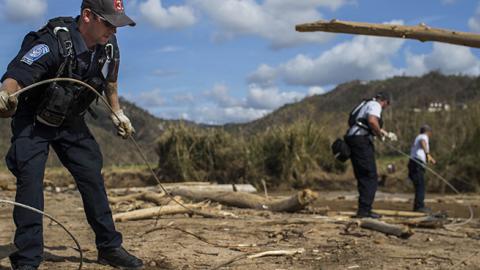The federal government deserved the rave reviews it earned for its responses to back-to-back hurricanes in Texas and Florida. The Federal Emergency Management Agency worked well with state and local officials and predeployed key resources and personnel. It seemed as though Washington had learned from its failed response to Hurricane Katrina in 2005. Yet as President Trump visits a Puerto Rico devastated by Hurricane Maria, cheers for FEMA have turned to boos. What went wrong?
First, Puerto Rico is an island. Getting resources in place before landfall was much more difficult than using the Interstate Highway System to move people and supplies. A FEMA official told me that “to say it’s logistically challenging is an understatement.”
The logistical challenge was compounded by the devastation on the island. The first responders in Puerto Rico were also victims, which meant many were unavailable to help with the response effort. The result is that FEMA must transport supplies as well as distribute them, which is typically a local responsibility and not FEMA’s real expertise.
In addition, it was harder for the residents themselves to evacuate when planes and boats were the only means of escape. We saw the lines of cars on Interstate 95 headed north from Florida before Hurricane Irma. Such an escape route was not available to Puerto Ricans or Virgin Islanders. At the same time, being cut off from the mainland made it that much harder for Good Samaritans to assist. A Dallas kosher caterer brought badly needed food to observant Jews in Houston who had been subsisting on Chex Mix after Hurricane Harvey. Dallas is 239 miles from Houston. Puerto Rico is only 110 miles wide, and the Virgin Islands even smaller, limiting the geographic range from which those willing to help could come.
FEMA must learn how to cope with serial disasters. As we saw with Harvey and Irma, post-Katrina reforms in 2006 improved FEMA’s “surge capacity”—its ability to handle more than one disaster at a time or in quick succession. But Texas and Florida are two of the best-prepared emergency-response states, which made FEMA’s job easier. Puerto Rico is less well-equipped.
Like any government agency, FEMA has limited resources. Its appropriations run out quickly in one disaster, let alone three, requiring a less-than-nimble Congress to vote for disaster funding. And FEMA personnel, who have been doing heroic work, are only human. They are subject to exhaustion when faced with a month of constant deployments and redeployments.
Finally, there is the issue of presidential focus. While Puerto Rico and the Virgin Islands reel, the president has also engaged in a feud with the National Football League over recent protests—perhaps not the best fight to take on during a series of natural disasters. This was made worse by failing health-care legislation, a new tax-reform effort and the Alabama special election, not to mention continued saber rattling from North Korea. The White House seemed ready for Harvey, but less prepared to cope with a spate of hurricanes for an entire month.
The lesson here is that presidential leadership is about continued effort in the face of ongoing challenges. As George W. Bush learned with Katrina, you can do a great job in dealing with weather disasters for four years, but the one you falter on is the one for which you’ll be remembered.




















